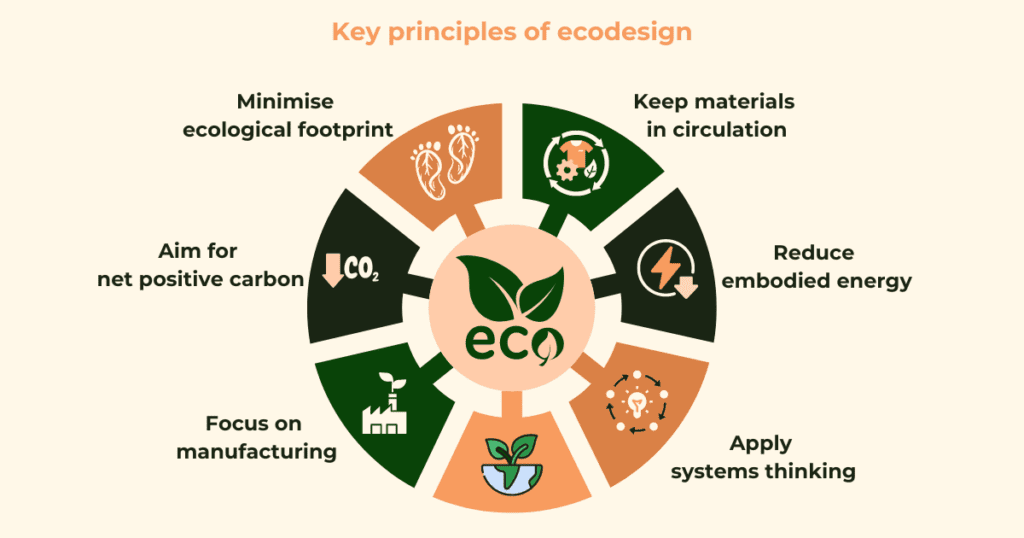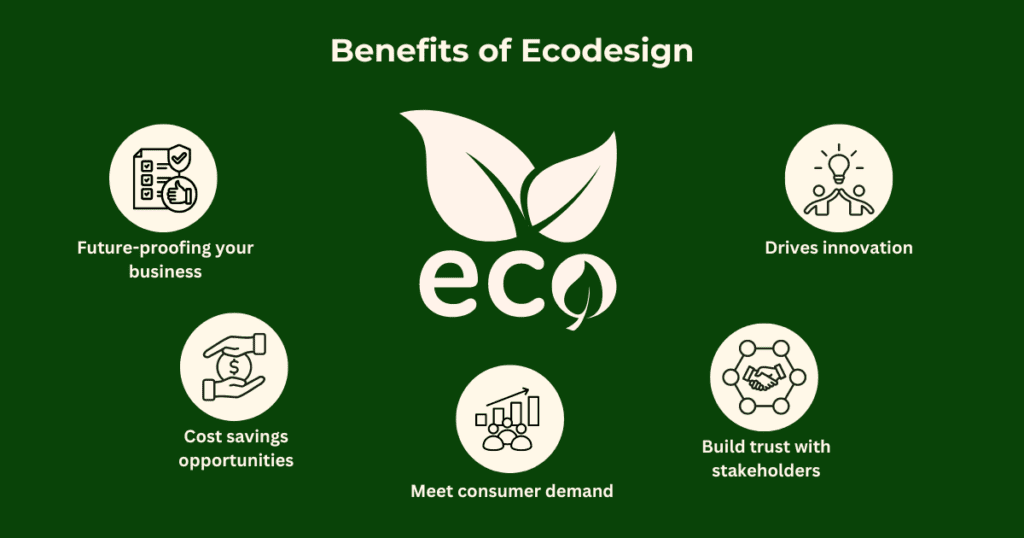Ecodesign explained
The environmental toll of overproduction and overconsumption is driving demand for more sustainable products. This presents both an opportunity and an obligation for companies to rethink how their products are designed.
With 80% of a product’s environmental impact being determined when it is designed and public pressure for action on environmental issues rising, companies are beginning to prioritise sustainable innovation.
In this blog, we will explain what ecodesign is and why it’s so important. We will also explore the benefits and challenges of implementing ecodesign, where to start, and how Life Cycle Assessment (LCA) is crucial in using ecodesign to create more sustainable products.
PUBLISHED: 25 September 2024
WRITTEN BY: Charlie Walter
What is ecodesign?
Simply put, ecodesign integrates sustainability into product design and aims to minimise the environmental impact of products. It’s about making sure sustainability isn’t an afterthought but prioritised at every stage of the product design process.
Life Cycle Assessment (LCA) is a crucial component of ecodesign. Ecodesign considers a product’s environmental impact throughout its life cycle – from raw material extraction to the disposal or recycling of a finished product. This concept is commonly called ‘Cradle to Grave’ thinking. We will explore this connection later in the blog.
Why is ecodesign important?
As mentioned, 80% of a product’s environmental impact is determined during product design. Therefore, embedding sustainability into your design process is crucial if your company wants to create more sustainable products.
Companies adopting ecodesign is linked to rising demand for more sustainable products, which is driven by three key trends:
-
Consumer demand
A decade ago, sustainability wasn’t a consideration for most consumers. Fast-forward to today and over 80% of consumers are willing to pay extra for more sustainable products. Generation Z is leading this charge, expecting brands to prioritise sustainability. This shift in values presents an opportunity for companies to meet the growing consumer demand for more sustainable products and help differentiate themselves from competitors.
-
Environmental regulations
Regulations are playing a pivotal role in accelerating the adoption of ecodesign. The Ecodesign for Sustainable Products Regulation (ESPR) is leading the way in Europe as it has minimum requirements for products to be designed with durability, repairability, recyclability and circularity in mind. This regulation also bans destroying unsold goods, forcing businesses to find sustainable solutions like reuse or recycling for their products.
-
Changing global consumption patterns
As the middle class in countries like India and China grows, so does the demand for Western-style, resource-intensive lifestyles. This creates significant environmental issues, such as an increasing demand for natural resources. Ecodesign offers businesses a way to respond to this challenge by creating products that use fewer materials and generate less waste.
Key principles of ecodesign
Several principles guide ecodesign:
- Minimise ecological footprint: Reduce a product’s environmental impact throughout its life cycle.
- Keep materials in circulation: Create products that keep materials in use for as long as possible, reducing waste and conserving resources.
- Reduce embodied energy: Minimise the total energy used throughout a product’s life cycle.
- Apply systems thinking: Consider the entire system around the product (for example the recycling infrastructure in the country where the product is used) to make more sustainable design choices.
- Focus on manufacturing: Explore ways to reduce carbon emissions, waste and resource consumption during production.
- Take inspiration from nature: Apply biomimicry to design products that mimic the efficiency of evolved biological systems.
- Aim for net positive carbon: Design products that offset more carbon than they emit over their life cycle, contributing to a net positive carbon impact.

Ecodesign and LCA
LCA and ecodesign are intrinsically linked. LCAs provide insights into a product’s environmental impact throughout its life cycle. This data equips design teams with the necessary information to ensure that every stage of a product’s life cycle is considered during the design process.
One of LCAs’ strengths is its ability to prevent siloed thinking. LCAs provide comprehensive data on various environmental impacts. This holistic approach helps companies avoid focusing on one environmental issue, like carbon emissions. It helps design teams make informed choices that consider the product’s total environmental impact.
LCAs also identify ‘hotspots’ in the product’s life cycle, enabling design teams to target areas with the highest potential for environmental improvement.
The key takeaway? LCAs provide the crucial data needed for robust ecodesign, empowering companies to use product-level insights to embed sustainability into product design.
Companies committed to ecodesign
When it comes to ecodesign leadership, several companies stand out for their bold initiatives:
Johnson & Johnson
Johnson & Johnson’s Earthwards program requires products to undergo an LCA and show measurable improvement in at least three of seven areas considered to be high-impact to become an Earthwards product. This program ensures sustainability is integrated into product design.
Mud Jeans
A pioneer in circular fashion, Mud Jeans offers a leasing program that encourages customers to return their jeans for recycling. This, combined with the brand’s use of recycled materials like cotton and stainless steel, has resulted in the company helping keep materials in circulation and reducing waste going to landfills.
Estée Lauder
Estée Lauder is leading the way with its green chemistry methodology, which integrates sustainable chemistry into product design. This innovative tool provides a quantifiable method to evaluate the sustainability of ingredients and packaging, helping create high-performing and more sustainable products.
These companies are proving that ecodesign is not just a trend but can be used to create more sustainable products and significantly reduce a company’s overall environmental impact.
Benefits of ecodesign
Ecodesign offers your company numerous benefits, including:
Future-proof your business
By focusing on ecodesign, you can stay ahead of environmental regulations that include ecodesign requirements and avoid supply chain disruptions. For example, using recycled materials helps your business become more resilient to future resource shortages.
Cost savings opportunities
Sustainable practices like improving energy efficiency and reducing waste during manufacturing can reduce operational costs. The most significant savings are often found in the value chain, especially when addressing Scope 3 emissions.
Meet consumer demand
With the rise of eco-conscious consumers, more sustainable products are in high demand. Creating more sustainable products sets you apart from competitors who do not prioritise the environment, boosting your brand’s reputation and building customer loyalty.
Build trust with stakeholders
Focusing on ecodesign builds trust with key stakeholders like employees and investors. Younger generations, in particular, want to work for purpose-driven companies. Adopting ecodesign can improve employee engagement by showing your commitment to creating more sustainable products.
Drives innovation
According to a McKinsey survey, more than 25% of total revenue and profits across industries come from launching new products. Focusing on ecodesign unlocks opportunities for innovation, driving business growth.

Ecodesign challenges
Embedding ecodesign into product design presents numerous challenges for companies. Below are the key obstacles companies typically face:
Untransparent supply chains
Many companies struggle to collect product footprint data because they lack full visibility into their supply chains. Without comprehensive data on a product’s environmental impact at each stage of its life cycle, implementing effective ecodesign becomes a challenge.
Are you curious to learn more about the importance of supply chain transparency? Read our blog here.
Lack of internal knowledge or capacity
Often companies lack the internal knowledge or resources to implement ecodesign. Interpreting LCA data and rethinking the entire product design process can be time-consuming and resource-intensive. Companies with already stretched product design teams often see this as a burden rather than a value-adding process.
No internal buy-in
Another hurdle is convincing leadership to balance sustainability with profit. Cost is often the main priority, and there is sometimes resistance to changing a financially successful product. Overcoming the ‘if it ain’t broke, don’t fix it’ mindset is key.
Long product development timelines
Companies with long development cycles may struggle to see the immediate benefits of ecodesign. Sometimes it takes years before the more sustainable products that use ecodesign enter the market, making it harder to justify the time and effort required.
Evolving regulations
Keeping up with regulations like that requires ecodesign can be time-consuming and resource-intensive. Ensuring products comply with future legislative requirements adds complexity to the design process.
High cost of innovation
Developing more sustainable products often requires upfront investment in new technologies, materials and processes. This can be a barrier to implementing ecodesign for small and medium-sized companies.
How to get started with ecodesign
So, how can companies implement ecodesign into product design? Below are several key steps to get started:
Conduct LCAs on your product portfolio
LCAs provide the data needed for robust ecodesign as they create detailed insights into each product’s environmental footprint. Companies often partner with automated LCA platforms like Root which can provide product footprints for entire product portfolios and use the data to guide ecodesign.
Create minimum requirements
Make sustainability a priority by setting minimum requirements that products must have to continue in your product design process.
Empower your design teams
Equip your teams with the right tools and knowledge to implement ecodesign. Train them to use LCA data effectively and create sustainability-related questions for your design team to consider at each stage of the product design process.
Gain internal buy-in
Having leadership support is crucial. To gain buy-in, highlight the environmental and non-environmental benefits of more sustainable products, such as cost savings and improved brand reputation. Educate senior leadership and your design team about the importance of sustainability and LCA-driven innovation.
Horizon scan for future regulations
Research and prepare for regulations that include ecodesign requirements like the Ecodesign for Sustainable Products Regulation. This will help you future-proof your products by ensuring they comply with these regulations.
Following these steps will enable your company to integrate ecodesign and create more sustainable products.
Root’s approach to ecodesign
At Root, we make measuring product footprints and implementing ecodesign simple. Here’s how we do it in three easy steps:
Retrieve data
First, upload your data onto Root’s platform. We need information about your purchase and sales orders to map your supply chain and details about your products, suppliers and transport routes.
Organise insights
Once your data is uploaded, Root’s platform will generate thousands of product life cycles at once, converting your product data into impact data.
Optimise impact
Now that you have the data, it’s time to take action. Our dashboards identify which materials or processes contribute the most to your product’s environmental impact. Additionally, using Root’s scenario builder, you can test different strategies to reduce each product’s environmental footprint. Our platform enables you to implement ecodesign and create more sustainable products easily.
Are you interested in learning more about how Root can help you with ecodesign? Book a demo with our experts here.
Root’s scenario builder comparing the material impact of a traditional versus organic cotton button up shirt ⬇

How we can help
At Root, we aim to redefine the norm by making product footprints universal. Our platform conducts automated LCAs for entire product portfolios – helping businesses report effectively on regulations, avoid greenwashing and become industry leaders in sustainability.
Root creates comprehensive product footprints that help businesses use ecodesign to create more sustainable products.
Interested to learn more? Get in touch with our team to discover how Root can help you achieve compliance and drive sustainable growth.
